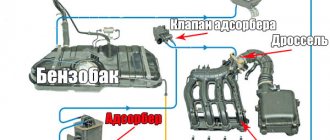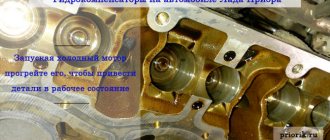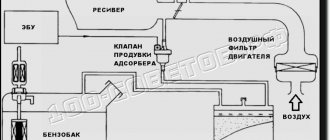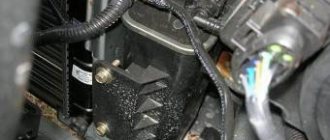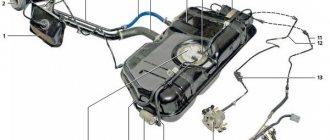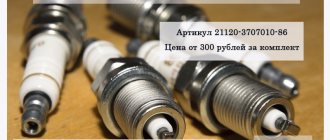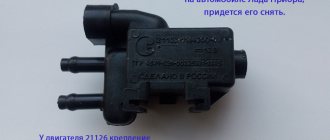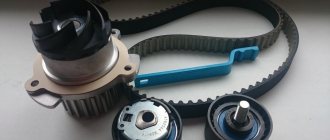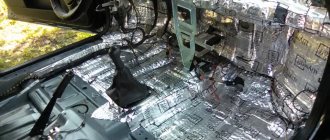More and more cars are appearing. This is no longer a luxury. Buying and driving a car, following all the rules, is one thing, but understanding how it works, how it works and how to maintain it is another matter. It is not easy for an ordinary driver to understand the numerous nuances of a car, including the Lada Priora.
It is necessary to have a general understanding of how to operate and maintain a car. Thanks to your knowledge, you can independently identify technical problems if necessary, and using the manual, you can fix them yourself.
On the Lada Priora car and a number of other domestic models there is such a part as the solenoid valve for purge the adsorber. Although it is secondary, it requires some attention to itself. It happens when the canister purge valve stops functioning. In this material we will tell you how to identify signs of a malfunction, plus what you need to pay attention to. How to manually replace a device.
Is it worth turning off the adsorber, pros and cons, possible consequences
Before turning off the adsorber in a car, it is important to understand how much this will affect the performance of the vehicle, including environmental ones, as well as driving safety.
In the article we will analyze the purpose and operating principle of the adsorber, where it is established, when it needs to be changed and whether it is possible to turn it off and drive without the device, how to properly remove it on a VAZ 2110, 2112, 2114, Lada Priora, Grant, Largus, Gazelle and whether it is necessary to flash the ECU after shutdown devices.
What is the correct name for an adsorber or absorber?
Both concepts exist in the world. But despite the fact that from the Latin “sorbeo” and “absorbeo” are translated almost identically: adsorber - (from Latin ad - on, with and sorbeo - absorb), and absorber - (from Latin absorbeo - absorb), the semantic load both words convey different meanings.
- In our case, we are talking specifically about an adsorber, since this is a device that, with its solid surface, absorbs gaseous or soluble substances without undergoing chemical reactions. There are periodic and continuous devices.
- And an absorber is a device that completely absorbs gases (vapors) inside, followed by a chemical reaction, as a result of which one of the substances is completely absorbed by a special liquid (absorber).
Therefore, for our situation, the first option will be correct.
Purpose and principle of operation
Adsorber - is a container filled with activated carbon, which acts as a filter element. This element is the main part of EVAP - Evaporative Emission Control (gasoline vapor recovery system).
The system has been integrated into the fuel system of cars with Euro-2 standards and higher. Those. you won’t see an adsorber on a VAZ classic or even a 2108 model, not to mention Moskvich, Volga 3110, etc.
The goal is to reduce harmful emissions into the atmosphere and eliminate gasoline odors in the car interior.
But despite the simplicity of the design, in addition to the housing and the filter element, the adsorber consists of:
- Branch pipes: air supply, vacuum, gasoline vapor removal.
- Separator - here the vapors are condensed and drained back into the tank.
- Gravity (emergency) valve – blocks the overflow of fuel when the machine overturns.
- The solenoid valve (or vacuum valve - for example, found on some Nissan models) is one of the important elements (details below).
- Other additional devices (depending on the car model).
Fuel vapors accumulating in the gas tank must go somewhere. In old cars they escaped into the atmosphere through a special tube. In modern vehicles, fuel tanks are isolated from the external environment.
Gasoline vapor, through a separate outlet pipe, enters the adsorber and condenses there in the form of fuel, which is returned back to the tank or to the intake manifold. In the first case, the process occurs with the engine turned off, in the second - with the engine running.
As soon as the car starts, the ECU sends a signal to the solenoid valve. The latter opens and the activated carbon (sorbent) is purged. Fuel vapors are “extracted” from the sorbent and immediately enter a special receiver and then into the combustion chamber.
To find out more about what an adsorber is, follow the link.
Error P0441
Owners of Lada Kalina often note that during the operation of the car, error P0441 appears, indicating that the gasoline vapor purge system is not operating correctly (the air flow differs from the norm). The cause of this malfunction may be:
- inoperative adsorber valve;
- clogging of the air line from the control unit to the air filter;
- air leakage through connecting pipes.
What should not be immediately considered is the line from the gas tank to the adsorber; here, a breakdown does not in any way affect the readings of the computer or diagnostic scanner. Still, most often Evap-Solenoid fails; this is a characteristic “disease” on Kalina.
If the EVAP valve stops functioning normally, it is not at all necessary that the engine will lose power, the fuel pump will fail, and so on. Mainly due to problems with the control gear, exhaust toxicity increases, and the Check Engine on the dashboard periodically lights up. There are car owners who do not pay attention to the diagnostic warning light, continuing to operate the car, but do not experience any great inconvenience. And most often in such a case, gasoline consumption does not exceed the norm, the engine starts normally, and no serious problems occur in the fuel system.
Where is it installed?
As a rule, the adsorber is installed under the hood on the right in the direction of travel of the car, for example, in the VAZ 2110 it is in the form of a barrel.
In other cars, it can be square and installed to the left of the engine (in the direction of travel), under the air duct (Lada Granta), the vacuum brake booster (some Nissan models) or in the radiator area. For VAZ 2114 it is located near the battery and air filter.
On the Volkswagen Passat B3, the adsorber is located under the air filter on the right side in the direction of travel.
Other vehicles - see your model's owner's manual.
Why do they refuse the adsorber?
Despite the advantages of this design solution, and these are: fuel economy, absence of odor in the cabin, reduction of harmful emissions into the atmosphere (although many do not care about this), the adsorber has a number of significant drawbacks, due to which many seek to disable it or completely remove it.
Disadvantages, they are also signs of malfunction:
- Expensiveness of the product (not for all cars). Replace or remove? More often, preference is given to the second option. For example, on an Acura MDX the price of the product varies within 10,000 rubles. For VAZ – from 800 rubles.
- A malfunction of the device leads to interruptions in the operation of the unit: the engine does not pull (poor acceleration of the car, stalls when driving uphill, transporting goods, floating idle speed on a warm engine, if the tank is plastic, then with a clogged adsorber, constantly compressing and unclenching (in the absence of a bypass valve in the lid), it may eventually burst due to the pressure of gasoline vapors; if it is metal, then it will become deformed. One of the characteristic signs of a malfunctioning adsorber is a hissing sound when the fuel tank lid is opened, caused by the movement of air into the tank (not out) and the appearance of the smell of gasoline in the cabin, incorrect fuel level.The appearance of error p0443 (the cause of the error is a clogged or faulty solenoid valve).
How to disable or remove the adsorber on a car and do you need to reflash the ECU?
You need to understand that when the adsorber is removed, the solenoid valve is turned off, which is directly connected to the controller and controlled by the latter.
This will lead to error p0443, which we already mentioned above. The tubes are also silenced, in particular the one that goes to the intake manifold.
What is the disadvantage of such a shutdown?
The fact is that through the tube that goes to the intake manifold, air is constantly sucked in; even in idle mode, the so-called small purge of the adsorber occurs. At high speeds from 1500 – 2000 and above there is a lot of purging.
In the ECU firmware, constant air leaks and the flow of fuel vapor are taken into account when forming the air-fuel mixture, despite the fact that all this goes past the mass air flow sensor, the causes of the malfunction of which can be found out by clicking on the link.
If you plug the pipe, which many people do, a certain amount of air will not flow into the intake manifold bypassing the ECU, but the latter still takes them into account.
That is, the controller takes into account one volume of air, but another (smaller) one actually enters. As a result, the amount of fuel is generated by the ECU based on more air than is supplied. This leads to an over-enrichment of the air-fuel mixture.
As a result, the engine does not work correctly, because the mixture is constantly over-enriched where it is and is not needed, and fuel consumption increases.
It is also worth talking about the transient mode of operation of the engine, which can manifest itself when approaching an intersection, a traffic light, lying to a policeman, at the moment when the gas is released.
At this moment, a failure may occur - a decrease in speed below idle. The engine seems to choke, it doesn’t have enough air, the reason is an over-enriched mixture. After a few seconds, the situation is resolved electronically.
Therefore, it would be correct to disable the adsorber in the following ways:
- After removing the device, install a nozzle with a diameter of 1 mm into the tube that goes directly past the mass air flow sensor. This will, at least partially, solve the problem, since only air without gasoline vapors will be supplied in doses.
- The ECU is being reflashed (difficult). If it is impossible to remove the Check error, you may need engine chip tuning, which is expensive.
- Dismantling the entire system except the solenoid valve, which operates idle.
- By installing a resistor (valve emulation) in the electrical circuit at 200 - 250 Ohms and 2 watts. To do this, bend the legs of the resistor and insert them into the valve chip. We secure everything with electrical tape. But this doesn't always help.
How to disable the adsorber on a VAZ 2110, 2112, 2114
Taking into account the recommendations above, we do the following:
- Disconnect the power connector from the valve.
- Disconnect all pipes from the adsorber and remove the latter along with the mount.
- We fix the valve in a place where the plug with wires and pipes will reach.
- Connect a hose with a fuel filter to the lower fitting (see photo below).
- To the upper end fitting we connect the pipe going to the intake manifold.
- We put another filter on the pipe going into the tank, similar to the first one.
With this scheme, when the valve opens, clean air enters the system, albeit without gasoline vapors.
We exclude the valve
This method is even simpler. We dismantle everything, including the valve. We put a fuel filter on the pipe coming from the gas tank, and we plug the pipe going to the intake manifold with a bolt and clamp.
The consequences of this method are described above, but this method also has the right to life.
As for Priora, Granta, Lada Largus, Gazelle and other cars, the absorber is turned off in similar ways as described above.
Toyota Chaser
It is worth considering one of the foreign cars, for example, the Toyota Chaser.
The shutdown principle is similar to the previous ones:
- Locate the canister valve. It is located near the mass air flow sensor on the air filter housing.
- Disconnect the chip with wires and all pipes from it (Check may light up on the instrument panel).
- Find the adsorber, disconnect the pipes from it and plug it.
- Disconnect the pipe going to the valve from the throttle assembly and plug it with a bolt and clamp.
- Place a fuel filter from a carburetor VAZ on the pipe going to the tank.
Checking the canister purge valve
1. Disconnect the block with wires and visually check the condition of the contacts. If oxides are detected on them, we treat the terminals with a means for cleaning and protecting electrical contacts.
2. Remove the adsorber valve. We measure the resistance of the valve winding with a multimeter, which should be within 20-30 Ohms. The canister valve should be replaced if a short circuit or break is detected in the valve winding.
3. To avoid short circuit, one terminal of the valve should be insulated with PVC pipe. We supply 12 V from the battery to the valve terminals. At this moment, the valve terminals should open with a characteristic click. We repeat the test, creating a vacuum in the valve with a rubber bulb.
Life hack: Priora car adsorber valve - check, replacement, price
Remember, like on sevens and shochs, before refueling you unscrew the tank, but the cap does not unscrew. Having strained myself, I went and heard such a loud hissing, as if you were opening a bottle of beer, not just a bottle, but a keg. To prevent such hissing, an adsorber valve was invented. 10 and Priora have this system.
But it’s not just a matter of hissing; it turns out that with this hissing, harmful fumes burst out, polluting the environment. The price is too expensive for today's ecology. And more importantly, the solenoid valve for purge the canister on a Priora car saves gasoline.
After turning off the car, the system begins to work, it drives vapors through the filter and returns fuel to the tank.
The adsorber itself on the Priora consists of a carbon filter - that is, there is carbon inside. The entire system consists of 11 spare parts. The adsorber for Priora is not expensive in itself, its price starts from 800 rubles. But the whole system costs from 5,450 rubles. Replacing a valve or adsorber on a Stoda will cost from 1000 rubles. Some drivers don't see the point in this system and simply remove it. Apparently the consumption is higher, or the Priora doesn’t go with it, it just knocks, and there’s 0 usefulness from it. They simply remove the adsorber valve, and instead put a fine filter, all gases naturally escape into the atmosphere. In fact, the working system does not affect traction in any way. The Priora drove its 11 seconds and continues to do so.
In rare cases, immediately after starting the engine, the car owner may be disturbed by a malfunction of the adsorber valve. This can be confused even with more serious breakdowns that relate to the incorrect operation of the internal parts of the Priora car engine - for example, it makes a clicking noise, which, unknowingly, can be confused with hydraulic compensators. In this article we have collected signs and malfunctions of the system, so read to the end.
The built-in purge valve for the Priora adsorber is, one might say, a necessity. It is precisely because of the presence of this part that the car meets European environmental safety standards. It runs much cleaner than older cars, and the valve itself allows you to save precious drops of gasoline to release them into the combustion chamber.
Prior canister valve crackling
- To the beginning of the forum
- Forum Rules
- Old design
- FAQ
- Search
- Users
Here's from the chiptuner: Question:
The sound of the adsorber valve is very audible.
How to fix it? Answer:
The adsorber valve, thanks to the outstanding VAZ acoustics, is best heard from the driver’s seat. . There is also a way to “pacify” the valve, suggested by Tom: you need to carefully pick out the epoxy covering the valve screw and turn it 1/2 - 3/4 clockwise. The valve will stop rattling and will still function normally.
I did it myself. Now I enjoy the silence.
Has anyone done this to themselves?
And where, actually, to pick?
Take a close look at the valve body itself, from the headlight side.
By the way, I didn’t have epoxy there, but white sealant, I didn’t even pick it out, but tightened the screw through it.
Another question: What is this screw for?
Please tell me what the character of this sound is. It’s quiet inside my cabin, but outside there’s something clicking in the adsorber—is that the sound?
The knocking sound of the adsorber does not sound like a clicking sound. It sounds more like a belt knocking on a plastic casing at engine speeds of approximately 1500-2000 rpm. You can hear it very well (for me it’s like this): the hood is closed, I’m driving slowly in 2nd gear, revs
2000, the door windows are closed, the heater is turned off, the music is too. Moreover, for some reason it can only be heard well from the driver’s seat.
Is this knocking noise constant or does it go away? I can’t determine what’s knocking - some say valve, others hydraulic - when you come to the service there’s never a knock.
No, the sound is not constant, I hear this sound only when the engine is warm, and when
But if you pick out the plug, problems with the IPG
, God knows what will happen to the brakes, the adsorber will be violating.
What is IPG
. And what does the brakes have to do with it?
What is IPG
. And what does the brakes have to do with it?
But if you pick out the plug, problems with the IPG are possible, God knows what will happen to the brakes, the adsorber will be damaged.
I missed something in this post.
problems with IPG, . the adsorber will be violative.
. strongly.
leon112 wrote: What is IPG. And what does the brakes have to do with it?
I'm tormented by the same 2 questions
I understand that IPG is a warranty engineer. And the adsorber will be to blame for the fact that the car will be removed from the warranty and the brakes will have to be repaired at its own expense. under a fortunate combination of circumstances. Sorry for the dark humor.
By the way, the topic was recently discussed with warranty providers - a colleague was tormented by the question “should I remove a self-installed radio or not?”
But I’m interested in another question: If the adjusting screw is filled with sealant, then it is necessary for some reason: WHY? Could there be a “keg of gunpowder” under the hood? Still, it “catches” gasoline vapors.
But I’m interested in another question: If the adjusting screw is filled with sealant, then it is necessary for some reason: WHY? Could there be a “keg of gunpowder” under the hood? Still, it “catches” gasoline vapors.
Exactly. The descriptions of the adsorber do not say anything about this bolt. I’ve been driving for the 4th day now, and everything seems to be working fine.
Then it’s not clear why the factory doesn’t immediately install the screw in such a position so that the adsorber doesn’t rattle.
The principle of operation of the adsorber on Priora
The breather is a container filled with activated carbon. Two hoses extend from it - outlet and inlet, and it itself is part of the engine power system. It operates like any storage tank: when gasoline vapors rise through the tubes from the gas tank, some of them manage to turn into liquid and flow down to the gas tank.
The second part of the vapor enters the inlet tube of the absorber and remains inside the container. They condense because activated carbon acts as a catalyst for the operation. The process occurs with the engine turned off - while the power system is at rest. After this, the fuel will be used by the engine.
The absorber valve, which operates on the principle of electromagnetic induction, is responsible for the release of fuel in the Lada Priora. The causes of malfunctions can be eliminated by simply replacing the Priora adsorber purge solenoid valve. A special absorber sensor is responsible for its movements. Like any other part that performs similar functions, it is critical to maintaining the functionality of the automotive system.
The ECU independently controls many of the processes taking place under the hood. Among his responsibilities is the preparation of the fuel-air mixture with the correct proportion. This means that the ECU must correctly use the available resources (fuel) by connecting the breather to work.
How is the valve checked?
To carry out this procedure you need:
- Disconnect the block with wires, and then visually check the condition of the contacts. If you find oxides, immediately treat the contact terminals with special cleaning agents.
- Then remove the valve and measure the resistance of its winding with a multimeter; it should be between 20 and 30 ohms. If a short circuit or winding break occurs, replace the part.
- Insulating one of the valve outlets with a PVC tube will help to avoid a short circuit. Apply 12 V from the battery to the contact terminals; their opening should be accompanied by a click. Then the test will need to be repeated by creating a vacuum in the valve using a rubber bulb.
Standard adsorber for Priora - article number, device, price and location
The breather of the Priora car absorber is located on the top left relative to the engine cover. Replacing the absorber valve is not difficult, given that the instructions and steps are simple. Finding it is quite easy: the breather hose goes to the throttle to direct fuel in the desired direction.
Gasoline consumption will depend on the quality of its operation - the efficiency of the power system will decrease, since part of the engine vapor will be released into the atmosphere, as was the case in old cars. The VAZ-2170 catalog implies the presence of the following components in the “Gasoline Vapor Recovery System”:
- Breather (adsorber valve) - 2170-01164042-00, price - about 800 rubles.
- Hose 115 cm long - 2170-01164087-20, price - about 500 rubles.
- Hose 70 cm long - 2108-31164103-10, cost - 350 rubles.
- Hose 90 cm long - 2110-31164109-12, cost - 400 rubles.
- Hose 25 cm long - 2110-31164105-12, cost - 150 rubles.
- Steam removal tube – 2170-01164084-01 – 150 rub.
- Front steam exhaust pipe – 2170-01164244-01 – 200 rub.
- Tube – 2170-01164282-00 – 300 rub.
- Adsorber – 2170-01164010-00 – 800 rub.
- Separator – 2170-01164005-01 – 1500 rub.
- Middle steam outlet tube - 2170-01164248-00 - 300 rubles.
To watch online, click on the video ⤵
Priora The absorber valve clicks loudly. More details
How to check the serviceability of the adsorber valve Read more
Adsorber. Why is it needed, how does it work, how to check. More details
11 problems with the adsorber and an error on the tidy Read more
High gas mileage? Gasoline consumption on gas? The reason is the absorber purge valve (APV)! More details
Lada Granta Canister Valve Replacement More details
The adsorber valve affects idle speed Read more
Error P0172 “Rich mixture” Causes and troubleshooting! Canister purge valve! More details
The adsorber valve no longer cracks Lada Vesta St. Cross spray silicone Read more
We disassemble the VAZ 2112 adsorber purge valve Read more
Lada Vesta. Do not do that! Lubricate the canister purge valve? Educational program - anti-obscurantism Read more
VAZ 2113-15 floats idle Read more
VAZ 2115 Jerks and dips when moving, stalls Read more
Does the idle speed fluctuate? Useful tips Read more
How to check air leaks on a car Read more
The engine stalls or stalls at traffic lights when the gas pedal is released Read more
If the gas tank cap squeaks when opening Read more
Idling problem solution Read more
Errors P0441-P0446. Test the purge valve using a tester. New project. More details
What can break - malfunctions
Symptoms of a system malfunction are often associated with two parts - a purge limiter, or an adsorber sensor (price from 350 rubles).
On a Priora car, signs of a system malfunction may be as follows: While the engine is idling, the speed fluctuates. The ECU must supply the correct amount of fuel to the injector to make its operation stable. Due to a lack of data (the sensor does not work), the ECU “goes astray”.
Fuel consumption has increased. In VAZ-2170 cars there may be several reasons for increased fuel consumption. The same bad gasoline familiar to all drivers creates a real troubleshooting puzzle. Therefore, the gasoline vapor recovery system may not be related to the breakdown - pay attention to other signs of malfunction.
The check light came on
- The engine, warmed up to normal temperature, does not start the first time. This means that the "exhaust" cannot open to allow fuel to flow to the throttle, and the engine does not receive gasoline to make the first cycle.
- Engine thrust has decreased. Acceleration has become very “heavy”, and the car seems to strain when the driver presses the gas pedal harder, increasing the speed.
- The breather of the Lada Priora absorber is knocking. An unpleasant clattering sound is due to the fact that the part is simply worn out.
The VAZ-2170 car is characterized by the following breakdowns related to the gasoline vapor recovery system:
- the winding is frayed or shorted;
- wiring damage;
- mechanical damage to the valve;
- sensor malfunction.
Signs of a sensor malfunction are:
- floating idle speed;
- unstable engine operation, loss of traction;
- poor acceleration (the engine cannot take “spare” gasoline from the absorber of gaseous substances.
Specific errors must be looked at using the diagnostic connector - this way the diagnostic information will be much more accurate.
Malfunctions in the fuel vapor recovery system Lada Kalina
Since the solenoid valve itself is not a complex device, it has few malfunctions as such - it may not open or close when necessary, or may freeze in a certain position. But the culprit of the breakdown may not only be Evap-Solenoid; the gasoline vapor recovery system does not work correctly for other reasons:
- connecting pipes are pinched or clogged;
- normal vacuum is not created in the system;
- due to an open circuit, there is no voltage on the valve;
- the carbon filter is completely clogged (which is rare);
- The control unit malfunctions.
If the CPA is stuck in the open position and does not block the channel, the following defects may occur:
- the fuel mixture becomes richer, causing “blackness” to appear on the electrodes of the spark plugs;
- the engine begins to operate unstably, this is especially noticeable at idle;
- gasoline consumption increases;
- The throttle response of the internal combustion engine decreases.
When the EVAP channel is constantly blocked by the purge valve, excess vapor pressure is created in the gas tank, due to this:
- there is a risk of fuel pump failure;
- The fuel level sensor may fail.
It should be noted that purge occurs in a certain mode after starting the engine, the program is executed depending on the crankshaft speed, and the system does not work at idle. An impulse arrives at the CPA if:
- the coolant has heated to a temperature of at least 75 degrees Celsius;
- the throttle valve is open at least 4%;
- the car is moving at a speed of more than 10 km/h (but this is not a necessary condition).
How to check the canister valve for functionality
To check the absorber limiter on the Priora, you will have to remove it. There is a difference regarding fastening. For engine 21126, the mount is a plastic casing, and for 21127 it is a mount that is located at the intake manifold. To remove a part, do the following:
- Stop the car, lift the hood, remove the negative terminal from the battery.
- Press the fastener of the lead wire and disconnect it.
- Press down on the latch. After this, slide the vent up along the guides.
- Disconnect the inlet pipe. If you can’t heat it up, pour hot water on it.
Check as follows:
- Inspect the hoses, look for mechanical damage if any.
- Try to fill the restrictor with air using a bulb or pump. At the same time, maintain the tightness of the small part - use clamps.
- If air is not blown through, the part works.
- Apply current from the battery. A click should appear as a signal to start working. When resetting the wire, you should hear another click, indicating proper operation.
Replacing the canister purge valve
To carry it out, you will need to sequentially perform the following steps:
- first, the latch's stupor moves upward;
- by pressing the latch, disconnect the block with wires from the valve;
- to disconnect the tube connecting the valve to the inlet pipeline, press the spring clips;
- the tube connecting the adsorber to the valve pipe is disconnected in the same way;
- The process will be completed by removing the valve itself from the bracket.
How to repair the adsorber and valve
Often the nature of damage to these parts is very large, since they operate under high wear conditions. The valve really shouldn't be repaired because the part is so small. But the main device often breaks down because the foam rots inside it. Coal breaks through the tubes and clogs the solenoid valve.
To repair, you will need to replace the foam separator. To do this, you will need to remove part of the gasoline vapor recovery system:
- Open the hood, stand on the left. Stretch your hand slightly down where the gasoline vapor recovery system is located (on the left edge).
- Clamp the two clamps that hold the separator outlet tubes. Remove the fitting tips.
- Using a “10” wrench, unscrew the bolts securing the radiator.
- Pull the adsorber towards you.
Source
